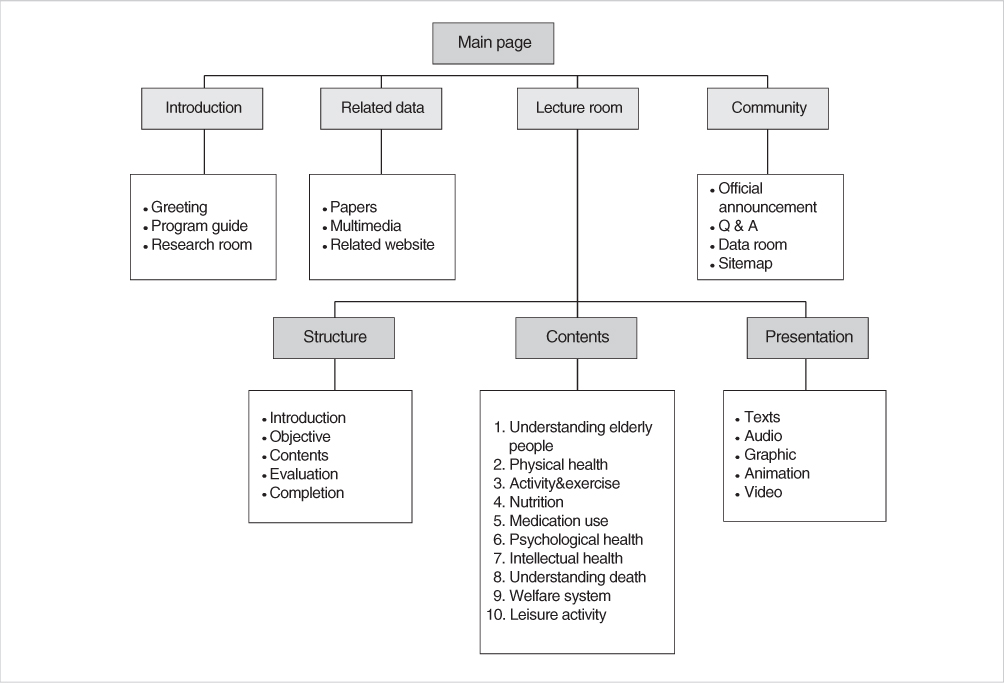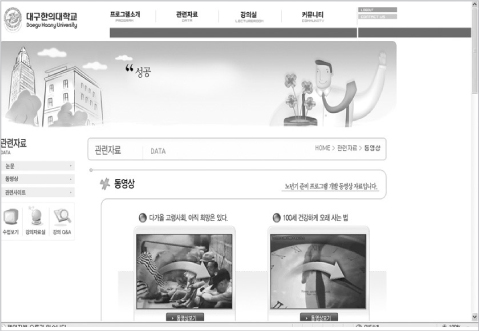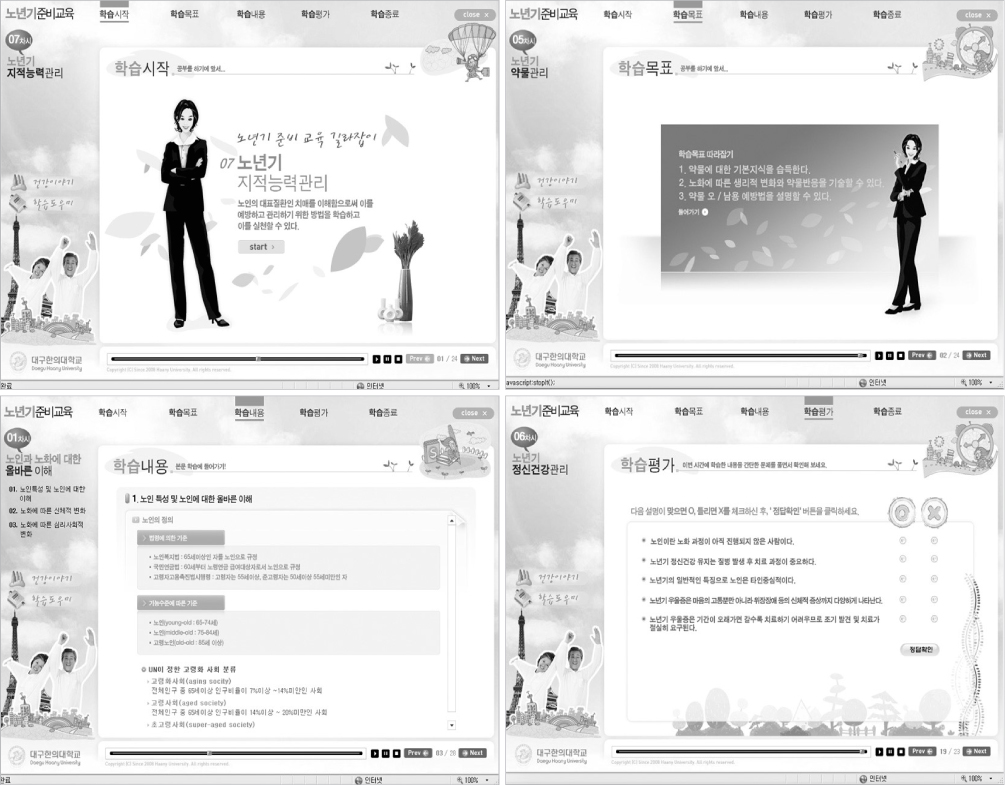J Korean Acad Nurs.
2008 Dec;38(6):831-842. 10.4040/jkan.2008.38.6.831.
Development of a Web-based Senescence Preparation Education Program for Successful Aging for Middle-aged Adults
- Affiliations
-
- 1Department of Nursing, Daegu Haany University, Daegu, Korea. youngmi@dhu.ac.kr
- KMID: 820138
- DOI: http://doi.org/10.4040/jkan.2008.38.6.831
Abstract
- PURPOSE
The purpose of this study was to develop a web-based senescence preparation education program to promote successful aging. METHODS: This program was developed based on Network-Based Instructional System Design (NBISD) model, using the following 5 processes: analysis, design, development, implementation, and evaluation. The program was operated for 10 weeks from March 17 to May 25, 2008. RESULTS: There were 4 menu bars, introduction, related data, lecture room, and communication on the main page. In the operation of this program, HTML, ASP, JAVA Script, Namo web editor, Edit Plus, Front Page and multimedia technology were applied. The program content consisted of understanding elderly people, physical health, activity & exercise, nutrition, medication use, psychological health, intellectual health, understanding death, welfare system and leisure activity. CONCLUSION: This program could be a useful means to provide senescence preparation information to middle-aged adults. Also, it is expected to offer individualized learning opportunities to many learners in various settings. Nurses should further develop and facilitate various learning strategies including web- based programs for elder care.
Keyword
MeSH Terms
Figure
Reference
-
1. Ahn BR. A study on the preparation of middle-aged employees for their retired lives. 2006. Seoul: Dongguk University;Unpublished master's thesis.2. Bullen M. Participation and critical thinking in online universitydistance education. Journal of Distance Education. 1998. 13:1–32.3. Cho ES. Study of efficiency in old age plan program for successful aging. 2006. Seoul: Ehwa Womans University;Unpublished master's thesis.4. Chung ES, Jeong IS, Song MG. Development and effect analysis of web-based instruction program to prevent elementary school students from safety accidents. Journal of Korean Academy of Nursing. 2004. 34:485–494.5. Chung HJ. Development and effectiveness of hemodialysis nursing education program using web-based learning system. 2000. Seoul: Yonsei University;Unpublished master's thesis.6. Chung HY, Kim SH. An empirical study on critical success factors in implementing the web-based distance learning system. Journal of Informational Systems. 2002. 11:51–74.7. Han JR. An action research on the curriculum of the aged education. 1993. Seoul: Yonsei University;Unpublished doctoral dissertation.8. Jin GH. Study on education to prepare for retirement. 1988. Seoul: Yonsei University;Unpublishedmaster's thesis.9. Jun GY, Song HA, Go SJ, Kim IM. Family life education program of preparing for successful aging. Journal of the Korean Gerontological Society. 2000. 20:69–91.10. Jung IS. Understanding of distance education. 1999. Seoul: Koyyuk Science Company.11. Jung IS, Lim CI, Choi SH, Leem JH. Effects of different types of interaction on learning and satisfaction in a web-based lifelong learning environment. Journal of Educational Technology. 2000. 16:223–246.12. Keller J, Burkman E. Fleming M, Levie WH, editors. Motivation principles. Instructional message design: Principles from the behavioral and cognitive sciences. 1993. Englewood Cliffs, NJ: Educational Technology Publications;3–49.13. Khan BH. Khan B, editor. Web-based instruction (WBI): What is it and Why is it? Web-based instruction. 1997. Englewood Cliffs, NJ: Educational Technology Publications;5–18.14. Kim BS, Yang ON, Kang I, Han EJ, Won MH. Life stage preparation program in an aged society. Journal of the Korean Gerontological Society. 2005. 25:229–244.15. Kim HJ. A study of research trends in the elderly education in Japan. Journal of Educational Research. 2007. 21:155–166.16. Kim HS. Effects of web-based diabetic education in obesediabetic patients. Journal of Korean Academy of Nursing. 2005. 35:924–930.17. Kim JS. Development and evaluation of a web-based support program for the maternal role of primipara. Journal of Korean Academy of Nursing. 2005. 35:165–176.18. Kim MR. Factors of successful aging affecting the life satisfaction of older women. Journal of the Korean Gerontological Society. 2008. 28:33–48.19. Lee SH. The development of educational program for the elderly and its effects. Journal of the Korean Gerontological Society. 2001. 21:85–98.20. Moore MG, Kearsley G. Distance education: A system view. 1996. Belmont, CA: Wadsworth.21. National information data. 2008. February. 01. Retrieved September 5, 2008. National Internet Development Agency;from http://isis.nida.or.kr/board/service/bbsView.jsp?bbs_id=3&item_id=773.22. Oh PJ, Kim IO, Shin SR, Jung HK. The effect of web-based multimedia contents for a course of physical examination and health assessment. Journal of Korean Academy of Nursing. 2005. 35:810–816.23. Rhee KO, Lee HS. Developing a group program of self-integration for the elderly. Journal of the Korean Gerontological Society. 2004. 24:37–52.24. Song MS. A study on relation between the counter-plan for old age life and characteristics of middle aged women. 2002. Seoul: Kyunggi University;Unpublished master's thesis.25. Sun Woo EJ. A study on the aged education to provide manhood's old age life. 2002. Seoul: Sookmyung Women's University;Unpublished master's thesis.
- Full Text Links
- Actions
-
Cited
- CITED
-
- Close
- Share
- Similar articles
-
- Development and Effects of Death Preparation Education for Middle-aged Adults
- Effects of a Health Promotion Program on Healthy Aging Preparation for Late Middle Aged Women
- Development of Health Information Program for the Middle Aged Women
- Factors Affecting the Successful Aging of Late Middle-Aged Adults
- Comparative analysis of successful aging in young-old and old-old adults based on Rowe and Kahn’s model: A secondary data analysis





